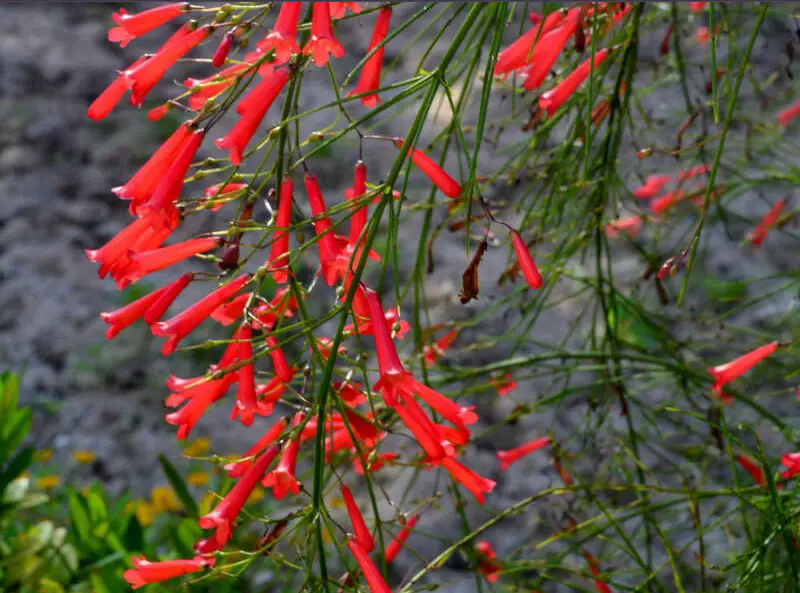Firecracker plants (Russelia equisetiformis), also known as coral plant or fountain plant, are beloved for their vibrant, tube-like flowers and trailing growth habit. Native to Mexico, these plants are known for their ability to brighten up any garden or patio with their brilliant red, orange, or yellow blooms that resemble a shower of fireworks. If you’re looking to add a touch of color to your garden, the firecracker plant could be the perfect choice.
This detailed guide will provide you with everything you need to know about firecracker plant care and growing. Whether you are a beginner or an experienced gardener, you will find tips on planting, watering, feeding, pruning, and dealing with common pests. Let’s dive into how you can grow and maintain a flourishing firecracker plant in your garden or home.
Introduction to Firecracker Plant

Firecracker plants belong to the plant family Plantaginaceae and are native to the southwestern United States, Mexico, and Central America. They are highly valued for their stunning display of tubular flowers that bloom from spring to fall. The plant itself has a distinctive growth habit with slender, arching stems that can trail up to several feet long.
Firecracker plants are low-maintenance, drought-tolerant shrubs that are excellent for hot and sunny locations. They are perfect for adding vertical interest to hanging baskets, containers, or as groundcover in a garden bed. Their flowers attract pollinators like hummingbirds, making them an ideal addition to wildlife-friendly landscapes.
Planting Firecracker Plants
Choosing the Right Location
Firecracker plants (Russelia equisetiformis) are sun-loving plants that require plenty of direct sunlight to thrive. To ensure your plant grows healthy and produces the vibrant, tubular flowers it’s known for, it’s essential to plant it in a location that receives a minimum of six hours of direct sunlight each day. While firecracker plants can tolerate partial shade, they will flower more sparsely if kept in shady areas. Therefore, to maximize their blooming potential, aim for a sunny spot in your garden or landscape.
These plants prefer warm climates and well-drained environments, making them an excellent choice for regions with hot, dry conditions. They do best in soil that is light and well-aerated, as poor drainage can lead to water accumulation around the roots, resulting in root rot. When choosing a planting location, make sure the area has good drainage and doesn’t retain water after rain or watering. Firecracker plants are also relatively adaptable to a variety of soil types, such as sandy, loamy, and clay-based soils. However, they flourish in slightly acidic to neutral pH levels (around 6.0 to 7.0), so it’s helpful to test the soil’s pH to ensure optimal conditions for growth.
Planting in Containers
Firecracker plants are versatile and can easily be grown in containers, making them a perfect option for both garden beds and indoor spaces. When choosing a container, make sure it’s at least 12-18 inches in diameter to allow the plant enough space to spread out. The container should have drainage holes at the bottom to prevent water from collecting and causing root rot. Using a well-draining potting mix is crucial for container plants, and adding ingredients like perlite or sand can help improve the aeration and drainage of the soil.
When growing firecracker plants in containers, place them in a spot where they can receive plenty of direct sunlight, such as a balcony, patio, or windowsill. These plants will not reach their full potential unless they have enough light. Container-grown firecracker plants typically require more frequent watering than those planted directly in the ground because containers dry out faster. Be sure to check the soil moisture regularly, and water the plant when the top inch of soil feels dry to the touch. Additionally, during the warmer months, you may need to water more frequently to keep the plant hydrated and healthy.
Watering and Soil Requirements
Watering Firecracker Plants
Firecracker plants are relatively drought-tolerant once they are established, but they still require consistent watering during their early growth phases to ensure strong root development. When watering, it’s important to water deeply, allowing moisture to reach the roots and encourage them to grow deep into the soil. However, avoid overwatering, as firecracker plants do not tolerate soggy conditions, which can lead to root rot. To avoid this, allow the top inch or two of soil to dry out between waterings.
During the warmer months, when the plant is actively growing and producing blooms, it may require more frequent watering to keep the soil adequately moist. In the winter, when the firecracker plant enters its dormant phase, watering needs decrease. It’s important to reduce watering during this time to prevent the soil from staying too moist, which could cause root rot. Always check the moisture level of the soil before watering—if the soil is still moist, hold off on watering until it dries out slightly.
Soil Requirements
Firecracker plants thrive in well-draining soil, as they are sensitive to standing water around their roots. Ideal soil for these plants is sandy or loamy, which allows for quick drainage and prevents the roots from sitting in excess moisture. If your soil is heavy or clay-based, amending it with organic material like compost can significantly improve drainage and soil structure, allowing the plant to thrive.
While firecracker plants can tolerate slightly less fertile soil, providing them with rich, well-draining soil will promote healthier growth and more prolific flowering. Compost or other organic matter can also boost the fertility of the soil, offering the plants the nutrients they need for vigorous growth. It’s important to ensure that the soil maintains an acidic to neutral pH range, as this supports optimal plant health. Adding organic matter regularly will not only help with soil fertility but will also improve the soil’s ability to retain moisture while allowing excess water to drain away.
Sunlight and Temperature Preferences
Sunlight Requirements
For firecracker plants to thrive and produce their signature vibrant blooms, they require full sun exposure. These plants perform best when they receive at least six hours of direct sunlight each day. If grown in conditions with insufficient sunlight, firecracker plants may exhibit sparse flowering and leggy growth, which can impact their overall health and appearance. To ensure a flourishing plant, always select a sunny spot in the garden or landscape.
If you are growing firecracker plants indoors, it’s important to place them near a south-facing window, where they will get plenty of direct sunlight. Alternatively, you can use grow lights to supplement the natural light, especially during the winter months or in regions with limited sunlight. Providing adequate sunlight is essential for encouraging the plant to bloom and maintain a compact, attractive shape.
Temperature Preferences
Firecracker plants are well-suited to warm climates, flourishing in USDA hardiness zones 9-11. These plants thrive in temperatures ranging from 60°F to 85°F (15°C to 29°C), making them an excellent choice for regions with mild to hot summers. While they are heat-tolerant, they may struggle in areas with freezing temperatures. If you live in a region that experiences cold winters, firecracker plants may not survive outdoors through the colder months.
In colder climates, you can grow firecracker plants as annuals, allowing them to complete their lifecycle during the warmer months before the first frost. Alternatively, if you are growing them in containers, you can bring the plants indoors or place them in a sheltered location to protect them from frost and freezing temperatures. Moving the plants to a warmer environment during winter ensures they remain healthy and protected until the spring.
Fertilizing Firecracker Plants
Firecracker plants benefit from regular feeding during their growing season to encourage lush foliage and abundant blooms. Use a balanced, water-soluble fertilizer with equal parts nitrogen, phosphorus, and potassium (such as 10-10-10) every 4-6 weeks during spring and summer. This will help the plant maintain vibrant growth and produce a profusion of flowers.
For firecracker plants grown in containers, fertilizing may be required more frequently since nutrients in the soil can be depleted faster. Be sure to follow the fertilizer manufacturer’s recommendations to avoid overfeeding, which can lead to excessive foliage growth at the expense of flowering.
In the fall and winter, when the plant is dormant, reduce fertilization. This will prevent the plant from putting out unnecessary growth when it is not actively blooming.
Pruning and Maintenance
Pruning Firecracker Plants
Pruning is a key component of firecracker plant care, helping to maintain both the plant’s appearance and its overall health. For the best results, prune your firecracker plant after it finishes blooming, which typically occurs in late fall or early spring. This is the ideal time to cut back any long or leggy stems, encouraging the plant to develop a more compact, bushy shape. When pruning, always cut just above a node (the small bump or “joint” on the stem), as this promotes new growth from that point.
In addition to shaping the plant, regular pruning allows you to remove dead or damaged branches, which helps to improve air circulation and reduce the risk of pests and diseases. If your firecracker plant has grown too large or unruly, you can prune it more severely. However, be cautious not to remove more than one-third of the plant at once, as cutting too much can put the plant under stress and may impact its ability to recover and thrive.
Maintenance Tips
Aside from pruning, another important aspect of maintaining a healthy firecracker plant is deadheading. This involves removing spent flowers regularly to encourage the plant to focus its energy on producing new blooms, rather than going into seed production. Deadheading not only promotes continuous blooming but also helps keep the plant looking neat and tidy. Simply pinch or cut off the spent flowers at the base, right where they meet the stem. Doing this regularly throughout the growing season will result in more vibrant, abundant flowers and keep your plant looking its best.
In addition to deadheading, it’s essential to continue monitoring the plant’s watering and soil requirements to ensure that it receives the proper care. With the right pruning and maintenance routine, your firecracker plant will remain healthy, full of blooms, and attractive throughout its growing season.
Firecracker Plant Pests and Diseases
Common Pests
Firecracker plants are relatively resistant to pests, but they can occasionally be affected by aphids, spider mites, and whiteflies. These insects can damage the plant by sucking sap from the leaves and stems, causing discoloration and stunted growth. If you notice pests on your plant, treat it with insecticidal soap or neem oil to control the infestation.
Snails and slugs can also be a problem, especially in moist conditions. Use organic methods like diatomaceous earth or iron phosphate-based baits to deter these pests.
Diseases
Firecracker plants are susceptible to root rot if overwatered or planted in poorly-drained soil. To avoid root rot, ensure proper drainage and avoid letting the plant sit in standing water.
Powdery mildew can occasionally affect firecracker plants, particularly in humid conditions. To prevent this, provide good air circulation and avoid overhead watering. If mildew appears, treat the plant with a fungicide or use a homemade solution of baking soda and water to control the spread.
Common Problems and Solutions
Yellowing Leaves
Yellowing leaves on a firecracker plant can be caused by overwatering, poor drainage, or nutrient deficiencies. Ensure the soil is well-draining and reduce watering if necessary. If the plant is lacking nutrients, a balanced fertilizer should help restore the plant’s health.
Poor Flowering
If your firecracker plant isn’t blooming, it may not be receiving enough sunlight. Make sure it’s planted in a location that receives at least six hours of direct sunlight daily. Additionally, inadequate fertilization or pruning too heavily can also affect flowering, so ensure proper care during the growing season.
Firecracker Plant Varieties
Firecracker plants, known for their striking, tubular flowers and vibrant colors, come in several varieties, each offering its own unique characteristics. The most popular and widely recognized variety is Russelia equisetiformis, often referred to as the “red firecracker plant.” This variety produces an abundance of slender, red tubular flowers that cascade from thin, arching stems. Its bright red blooms attract hummingbirds and pollinators, making it a perfect addition to gardens seeking to bring wildlife into the space. Russelia equisetiformis thrives in full sun and well-draining soil, and it can be grown both in containers or directly in the ground.
Another variety, Russelia juncea, offers a different aesthetic with its yellow flowers. While it still maintains the same slender, tubular shape of the flowers, the vibrant yellow hue sets it apart from the red-flowered species. This variety is ideal for those who want to add a contrasting burst of color to their landscape, blending well with other flowering plants to create an eye-catching display. The Russelia juncea also grows well in full sun and prefers dry to moderately moist soil, similar to its red-flowered cousin. Its unique yellow flowers make it an attractive option for garden designs focused on warm tones or sunny themes.
Beyond these two primary varieties, there are other lesser-known firecracker plant types that exhibit different color variations or growing habits, providing even more options for gardeners to explore. When choosing the right firecracker plant for your space, consider factors such as your local climate, soil type, and desired color scheme. Both varieties can tolerate heat and drought once established, making them suitable for xeriscaping or low-maintenance gardens.
Firecracker Plant Uses in Landscaping
Firecracker plants are excellent for various landscaping purposes. They are ideal for hanging baskets, containers, or as ground cover in garden beds. Their trailing habit makes them a popular choice for cascading over walls, fences, or trellises.
They are also perfect for attracting hummingbirds and other pollinators to your garden. Whether planted as a standalone specimen or in mixed borders, firecracker plants add color and movement to any garden setting.
Conclusion
Firecracker plants are a vibrant, low-maintenance addition to any garden, offering stunning flowers and attracting pollinators. By providing the right growing conditions—plenty of sunlight, well-draining soil, and appropriate watering—you can enjoy a flourishing firecracker plant throughout the year. Regular pruning, fertilization, and pest control will keep your plant healthy and ensure it thrives in your garden for years to come.
Whether you grow it in the ground or in containers, the firecracker plant is sure to brighten up your space with its fiery blooms and attractive foliage. Happy gardening!






